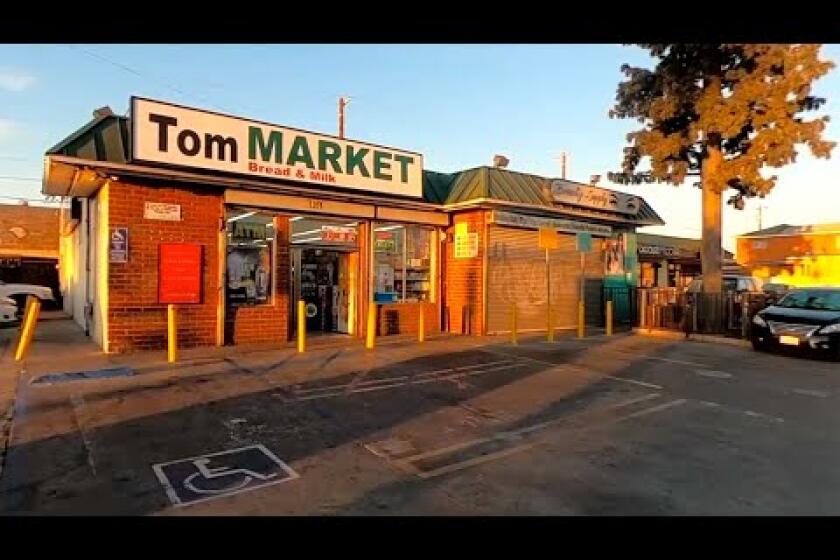Reflections of the L.A. uprising: Revisiting the photographs

Photographers David Butow, Hyungwon Kang, Kirk McKoy and Ted Soqui return to seven locations 30 years after capturing award-winning images from the L.A. uprising.
- Share via
Welcome to Los Angeles in the last few days of April 1992.
Four photographers recall the moments leading up to and surrounding some of their most iconic photos of the L.A. uprising.
Ted Soqui was a photographer for LA Weekly during the 1992 uprising, one of the only professional photographers to capture the burning palm trees of L.A.
“I saw someone burning a palm tree, and they were using a long pole with a flag on it, and I didn’t really realize it was an American flag,” Soqui said, “until I printed the image.”
Tom’s Market overlooks the intersection of Florence and Normandie — the flashpoint of the 1992 L.A. riots.
“The subject kind of intrigued me; not only was he holding a flag, he was masked. Back 30 years ago, not many people wore masks during demonstrations.”
After spending daylight hours shooting photos, Soqui would process and develop the film overnight in his garage. Constrained by the closure of photography stores in Los Angeles, he shot mostly in black and white film, which was faster and easier to develop on his own.
David Butow witnessed many historical events through the lens of his camera as a freelance photojournalist, including the 1992 uprisings in L.A., the 2003 invasion of Iraq, and the 2019 protests in Hong Kong. Most recently, he was in Ukraine shooting photographs of the war.
Hyungwon Kang focused his photography on the experiences and emotions of Korean Americans during the L.A. uprising. With his Korean, Kang was able to put subjects of his photography at ease, becoming a fly on the wall during the events of April 1992. Kang is currently a freelance photojournalist and won a Pulitzer Prize for his coverage of the 1992 uprising for the Los Angeles Times.
Kirk McKoy, also a Pulitzer Prize-winning staff photographer for The Times, immersed himself fully in the 1992 protests just before the intersection of Florence and Normandie became the primary subject of police attention. He recalls witnessing one protest on the evening of April 29, 1992, at the corner of Crenshaw and West Adams.
“When I arrived on the scene, there were already people out on the streets, banging pots and pans, already holding homemade signs,” McKoy said. “Right after that, I turned around, looked up and saw a bunch of helicopters circling an intersection, which happened to be Florence and Normandie, and figured, ‘That’s the place to be.’”
Augmented reality

View these historical images overlaid on present-day 360º video in this immersive piece, and hear from the photographers themselves. Select the links below using Snapchat on your smartphone to walk through an augmented reality doorway to examine the space around you.
Kirk McKoy talks about how he moved from protest to protest the night of April 29, 1992.
David Butow recalls taking photos of burning rubble just a couple blocks from his L.A. apartment in 1992.
Hyungwon Kang discusses how he used his Korean fluency to blend in among activists in Koreatown.
Ted Soqui remembers spotting burning palm trees next to the freeway in downtown L.A.
More to Read
About the Jovrnalism Reflections of the L.A. Uprising virtual reality project
Additional thanks to Robert Hernandez, founder and professor of the USC Annenberg Jovrnalism course.
Sign up for Essential California
The most important California stories and recommendations in your inbox every morning.
You may occasionally receive promotional content from the Los Angeles Times.











